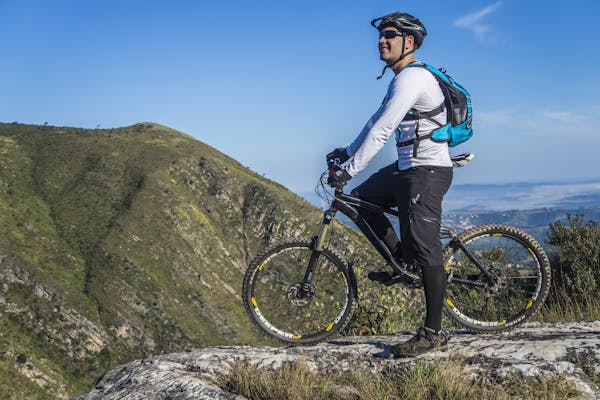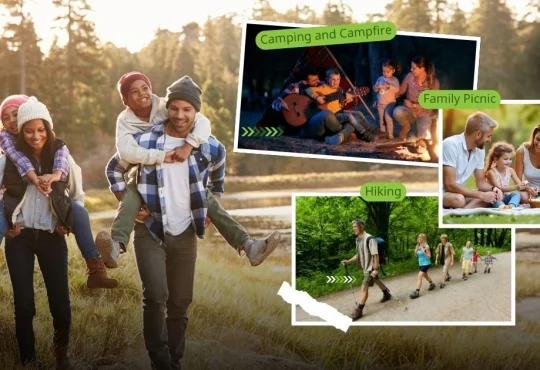Essential Gear and Equipment for Cyclists
Cycling is a rewarding and enjoyable activity that offers numerous benefits, from fitness to mental well-being. Whether you’re commuting to work, training for a race, or simply enjoying a weekend ride, having the right gear and equipment is essential for both performance and safety. In this guide, we’ll cover the essential gear and equipment for cyclists, breaking down each category to ensure you’re fully prepared for your next ride.

Essential Gear and Equipment for Cyclists
1. The Bicycle: Your Ultimate Companion
The most important piece of gear for any cyclist is, of course, the bike itself. Choosing the right bicycle depends on the type of cycling you plan to do. Here are the most common types:
- Road Bike Designed for speed and efficiency, road bikes are ideal for long-distance rides on paved surfaces. They feature lightweight frames, narrow tires, and drop handlebars, making them aerodynamic and perfect for covering miles swiftly.
- Mountain Bike built for off-road adventures. With wider tires, robust frames, and suspension systems, they are ideal for rugged terrains. If you enjoy trail riding, a mountain bike will be your go-to choice.
- Hybrid Bike Combining features of both road and mountain bikes, hybrid bikes offer versatility. They’re excellent for commuting, leisure rides, and light off-road use. Their comfortable geometry and moderate tire size make them great all-rounders.
- Electric Bike (E-bike) Becoming increasingly popular due to their electric motor assistance. Perfect for commuting or long rides with hilly terrain, they reduce the effort needed to pedal, making cycling accessible to a wider audience.
When selecting a bike, ensure it fits your body properly. A well-fitting bike enhances comfort, prevents injury, and optimizes performance.
2. Helmet: Safety First
A helmet is perhaps the most critical piece of safety equipment for cyclists. Head injuries are a leading cause of fatalities in cycling accidents, and a helmet significantly reduces this risk. Look for a helmet that meets safety standards (such as CPSC, ASTM, or CE certification) and fits snugly on your head without being uncomfortable.
- Road Helmets These are designed for road cycling, with a lightweight design and good ventilation. Their aerodynamic shape helps reduce drag and keeps you cool on long rides.
- Mountain Bike Helmets are more rugged, offering extra protection around the back of the head. They may also feature a visor to protect your eyes from sun, mud, and debris.
- Commuter Helmets often prioritize visibility and safety over aerodynamics. Many models include features like integrated lights, reflective elements, and MIPS (Multi-directional Impact Protection System) technology for enhanced protection.
Always replace your helmet after a crash or every few years, as the materials degrade over time, reducing its effectiveness.
3. Cycling Clothing: Comfort and Performance
Wearing the right clothing makes a significant difference in your cycling experience. Cycling-specific clothing is designed to enhance comfort, improve aerodynamics, and protect you from the elements.
- Jerseys A good cycling jersey is lightweight, breathable, and moisture-wicking. It helps regulate your body temperature and keeps sweat away from your skin. Look for jerseys with pockets in the back to store essentials like snacks, a phone, or a multi-tool.
- Cycling Shorts Cycling shorts are padded (with a chamois) to reduce discomfort and chafing during long rides. The snug fit also reduces drag, helping you ride more efficiently. Bib shorts, which include shoulder straps, offer extra support and prevent the shorts from slipping down.
- Base Layers Base layers, made from moisture-wicking fabrics, are worn under your jersey to regulate body temperature. Choose a thin, breathable base layer for warm weather and a thermal one for colder rides.
- Jackets For cold or wet conditions, a cycling jacket is essential. Lightweight, packable jackets offer wind and water resistance without adding bulk. In colder climates, a thermal jacket with insulation will keep you warm during your ride.
- Cycling Gloves Cycling gloves improve grip, reduce hand fatigue, and protect your hands in the event of a fall. In warm weather, short-fingered gloves keep your hands cool, while full-fingered gloves offer warmth and protection in colder conditions.
4. Footwear and Pedals: Power Transfer and Comfort
Your shoes and pedals are crucial components in ensuring comfort, efficiency, and power transfer.
- Cycling Shoes Cycling shoes are designed to work with clipless pedals, which attach your feet to the pedals for better power transfer and control. Road cycling shoes are stiff and lightweight, designed for efficiency, while mountain biking shoes offer more grip and protection for rough terrain.
- Pedals There are several types of pedals, but the most common for cyclists are clipless pedals. These allow you to “clip in” your shoes, increasing pedaling efficiency. Mountain bike pedals typically offer easier disengagement, making them suitable for off-road conditions.
If you’re a beginner, you might start with flat pedals, which don’t require special shoes and are easier to use in urban or casual riding environments.
5. Lights: Be Seen, Stay Safe
Whether you’re riding during the day or at night, proper lighting is essential for safety. Bike lights make you visible to other road users and help illuminate the path ahead.
- Front Lights A powerful front light is crucial, especially for night riding. Look for a rechargeable, LED light with at least 200 lumens for urban riding and 500 lumens or more for unlit roads or trails.
- Rear Lights A bright, flashing red rear light is key for making you visible to drivers approaching from behind. Many modern rear lights are USB-rechargeable and offer various lighting modes for added visibility.
- Helmet and Wheel Lights Helmet-mounted lights provide extra visibility and allow you to see where you’re looking, while wheel lights add a layer of safety by increasing your visibility from the side.
6. Essential Repair Tools and Accessories
Every cyclist should carry a few basic tools and accessories to handle common roadside repairs. Being prepared can mean the difference between getting home safely and being stranded miles from help.
- Spare Tubes and Patch Kits Flat tires are inevitable, so always carry at least one spare inner tube and a patch kit. Knowing how to change a tube is an essential skill for any cyclist.
- Tire Levers It help you remove the tire from the rim when fixing a flat. Look for lightweight, durable options that are easy to carry in your saddlebag.
- Mini Pump or CO2 Inflator A mini pump or CO2 inflator is a must-have for inflating your tires after a puncture. While mini pumps are more reliable, CO2 inflators offer quicker inflation in emergencies.
- Multi-tool A good multi-tool includes all the essential wrenches, screwdrivers, and chain tools needed to perform minor repairs on the go. Look for one with an integrated chain breaker, as broken chains can end a ride quickly if not fixed.
- Chain Lube Regularly lubricating your chain improves your bike’s performance and extends the life of its components. Carry a small bottle of chain lube with you, especially on long rides or in wet conditions.
- Saddlebag or Tool Roll A saddlebag or tool roll provides convenient storage for your repair kit. Choose a compact, durable bag that can be easily attached to your bike without hindering your ride.
7. Hydration: Stay Fueled and Hydrated
Proper hydration is critical when cycling, especially during long rides or in hot weather.
- Water Bottles and Cages A good water bottle is essential for keeping hydrated on the bike. Look for bottles with easy-to-use caps and a secure, no-slip grip. Bottle cages are mounted on your bike’s frame, allowing you to easily access your bottle while riding.
- Hydration Packs For mountain bikers or those on longer rides, a hydration pack offers the advantage of carrying more water, as well as additional storage space for tools, snacks, and other essentials.
8. Navigation and Technology: Stay on Track
Technology has become an integral part of cycling, with various gadgets available to enhance your ride.
- GPS Bike Computers A GPS bike computer tracks your speed, distance, elevation, and route, making it a great tool for both navigation and training. Advanced models offer features like route mapping, turn-by-turn directions, and integration with training apps.
- Smartphone Mounts For cyclists who prefer using their smartphones for navigation, a secure phone mount ensures easy access to maps and ride-tracking apps. Look for mounts that are sturdy and designed to withstand road vibrations.
- Heart Rate Monitors and Power Meters For serious cyclists looking to improve performance, heart rate monitors and power meters provide valuable data about your exertion and energy output. These devices help fine-tune your training and maximize efficiency.
9. Eyewear: Protect Your Eyes
Cycling eyewear serves multiple purposes, from protecting your eyes against UV rays to shielding them from wind, dust, and insects.
- Sunglasses Sunglasses with UV protection are essential for sunny rides. Choose lenses that offer clarity and reduce glare, and ensure the frames fit snugly to prevent them from slipping during your ride.
- Clear Lenses For cloudy or night rides, clear lenses provide protection without darkening your vision.
11. Cycling Accessories: Enhancing Your Experience
In addition to the essential gear and equipment, various accessories can significantly enhance your cycling experience. These items may not be strictly necessary but can add convenience, comfort, and style to your rides.
- Bike Lock A sturdy bike lock is essential for securing your bike when you need to leave it unattended. U-locks and chain locks are popular options; U-locks generally offer better security, while chain locks can be more versatile. Always ensure your lock is high-quality and pick-resistant.
- Bike Bag or Panniers For longer commutes or touring, a bike bag or panniers can provide additional storage space for your belongings. Panniers attach to a rear rack, allowing you to carry groceries, clothing, or even a laptop. Choose waterproof options to protect your items from the elements.
- Fenders are Invaluable for commuting or riding in wet conditions. They prevent water and mud from splashing up onto you and your bike, keeping you cleaner and more comfortable during your ride.
- Handlebar Tape For road cyclists, handlebar tape can enhance grip and comfort. There are various materials and thicknesses available, allowing you to customize your bike’s feel. Consider thicker tape for more cushioning on longer rides.
- Bike Stand A bike stand makes maintenance easier by allowing you to work on your bike without laying it on the ground. It can be especially useful for cleaning and adjusting your bike’s components.
12. Understanding Your Riding Style
Different cycling disciplines and styles call for specific gear and equipment, so it’s essential to understand your preferences. Here are a few common riding styles to consider:
- Commuting If you’re using your bike for commuting, focus on gear that prioritizes visibility, comfort, and utility. Essential gear for commuters may include fenders, lights, a comfortable seat, and a bike bag for carrying work items.
- Touring Touring involves longer distances and often requires more extensive gear. Essential equipment includes a sturdy touring bike, panniers for carrying supplies, a reliable navigation system, and a robust repair kit. Comfort-oriented accessories like a quality saddle and adjustable handlebars are also key for long rides.
- Mountain Biking For off-road riding, focus on rugged gear that can handle rough terrain. Essential items include a mountain bike with suspension, protective gear like knee and elbow pads, a hydration pack, and durable clothing designed to withstand abrasions.
- Competitive Racing Racers prioritize lightweight, aerodynamic gear to enhance performance. This includes a high-end road bike, clipless pedals, and streamlined clothing. Accessories like power meters and heart rate monitors are crucial for training and race strategy.
13. Cycling for Different Seasons
Adjusting your gear according to the season is vital for comfort and safety. Here’s a breakdown of essential gear for cycling in various weather conditions:
a) Spring and Summer
- Lightweight Clothing: Opt for moisture-wicking jerseys and shorts to stay cool.
- Sunscreen: Protect your skin from UV rays with high-SPF sunscreen.
- Hydration Systems: Carry enough water and electrolyte drinks to prevent dehydration.
b) Autumn
- Layering: Choose breathable base layers, long-sleeve jerseys, and a lightweight jacket.
- Visibility Gear: As daylight hours decrease, bright colors and reflective gear are essential for visibility.
c) Winter
- Insulated Clothing: Invest in thermal jerseys, tights, and waterproof outer layers to stay warm and dry.
- Cold Weather Accessories: Use gloves, shoe covers, and a balaclava or face mask to protect extremities from the cold.
14. Maintaining Your Gear
To ensure your cycling gear lasts and performs optimally, regular maintenance is crucial. Here are some essential maintenance tips:
- Regular Cleaning Keep your bike clean to prevent dirt buildup, which can damage components. Wash your bike after rides, especially in wet or muddy conditions, and lubricate the chain regularly to ensure smooth operation.
- Inspect Components Periodically check your bike’s components, including brakes, tires, and gears. Look for signs of wear and replace parts as necessary. Regular maintenance can prevent minor issues from becoming major problems.
- Tire Care Maintain proper tire pressure for optimal performance. Check your tires for cuts or wear and replace them if they’re worn out. Carry a portable tire gauge to ensure you’re riding with the correct pressure.
- Brake Adjustment Ensure your brakes are functioning correctly. Check the brake pads for wear and adjust the brake cables if necessary. Properly functioning brakes are crucial for your safety.
15. Investing in Quality Gear
While it may be tempting to purchase the cheapest options available, investing in high-quality gear pays off in the long run. Quality gear tends to be more durable, performs better, and enhances your overall cycling experience.
- Research and Reviews Before making a purchase, research various brands and read reviews from other cyclists. Look for gear that is well-reviewed and recommended for your specific riding style.
- Test Before You Buy Whenever possible, test equipment like bikes, shoes, and helmets before purchasing. Many bike shops allow you to take bikes for a test ride, which can help you make an informed decision about fit and comfort.
- Consider Used Gear For those on a budget, consider buying used gear. Many cyclists sell gently used items at a fraction of the original cost. Just ensure that the gear is in good condition and meets safety standards.
16. Cycling Etiquette and Safety Tips
Cycling is not only about the gear but also about being a responsible road user. Here are some essential etiquette and safety tips to keep in mind:
- Follow Traffic Laws Always adhere to local traffic laws and regulations. This includes obeying stop signs, and signals, and riding in the correct direction on the road.
- Use Hand Signals Communicate with other road users by using hand signals when turning or changing lanes. This helps alert drivers and other cyclists to your intentions.
- Be Mindful of Your Surroundings Stay aware of your surroundings and anticipate potential hazards, such as potholes, pedestrians, or opening car doors. Always keep a safe distance from other road users.
- Ride Predictably Maintain a straight line and avoid sudden movements. Riding predictably helps ensure the safety of both yourself and others on the road.
- Wear a Helmet Always wear a properly fitted helmet, as it significantly reduces the risk of head injuries in the event of an accident. Make it a non-negotiable part of your cycling gear.
Equipped with the right essential gear and equipment for cyclists, you’re now ready to embark on your cycling adventures. Whether you’re commuting, touring, or racing, each piece of gear contributes to a safer and more enjoyable ride.
Remember that cycling is not just about the destination; it’s about the journey, the experiences, and the joy of being outdoors. Stay safe, enjoy the ride, and let your cycling journey be as rewarding as the destinations you reach.





